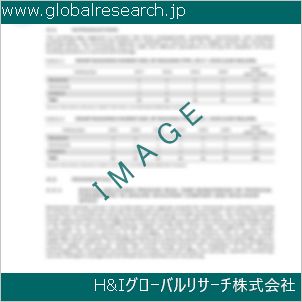Table of Contents
1 Industry Overview of Bromoform
1.1 Definition and Specifications of Bromoform
1.1.1 Definition of Bromoform
1.1.2 Specifications of Bromoform
1.2 Classification of Bromoform
1.3 Applications of Bromoform
1.3.1 Nuclear Application
1.3.2 Non-Nuclear Application
1.4 Industry Chain Structure of Bromoform
1.5 Industry Overview and Major Regions Status of Bromoform
1.5.1 Industry Overview of Bromoform
1.5.2 Global Major Regions Status of Bromoform
1.6 Industry Policy Analysis of Bromoform
1.7 Industry News Analysis of Bromoform
2 Manufacturing Cost Structure Analysis of Bromoform
2.1 Raw Material Suppliers and Price Analysis of Bromoform
2.2 Equipment Suppliers and Price Analysis of Bromoform
2.3 Labor Cost Analysis of Bromoform
2.4 Other Costs Analysis of Bromoform
2.5 Manufacturing Cost Structure Analysis of Bromoform
2.6 Manufacturing Process Analysis of Bromoform
3 Technical Data and Manufacturing Plants Analysis of Bromoform
3.1 Capacity and Commercial Production Date of Global Bromoform Major Manufacturers in 2023
3.2 Manufacturing Plants Distribution of Global Bromoform Major Manufacturers in 2023
3.3 R&D Status and Technology Source of Global Bromoform Major Manufacturers in 2023
3.4 Raw Materials Sources Analysis of Global Bromoform Major Manufacturers in 2023
4 Capacity, Production and Revenue Analysis of Bromoform by Regions, Types and Manufacturers
4.1 Global Capacity, Production and Revenue of Bromoform by Regions 2019-2024
4.2 Global and Major Regions Capacity, Production, Revenue and Growth Rate of Bromoform 2019-2024
4.3 Global Capacity, Production and Revenue of Bromoform by Types 2019-2024
4.4 Global Capacity, Production and Revenue of Bromoform by Manufacturers 2019-2024
5 Price, Cost, Gross and Gross Margin Analysis of Bromoform by Regions, Types and Manufacturers
5.1 Price, Cost, Gross and Gross Margin Analysis of Bromoform by Regions 2019-2024
5.2 Price, Cost, Gross and Gross Margin Analysis of Bromoform by Types 2019-2024
5.3 Price, Cost, Gross and Gross Margin Analysis of Bromoform by Manufacturers 2019-2024
6 Consumption Volume, Consumption Value and Sale Price Analysis of Bromoform by Regions, Types and Applications
6.1 Global Consumption Volume and Consumption Value of Bromoform by Regions 2019-2024
6.2 Global and Major Regions Consumption Volume, Consumption Value and Growth Rate of Bromoform 2019-2024
6.3 Global Consumption Volume and Consumption Value of Bromoform by Types 2019-2024
6.4 Global Consumption Volume and Consumption Value of Bromoform by Applications 2019-2024
6.5 Sale Price of Bromoform by Regions 2019-2024
6.6 Sale Price of Bromoform by Types 2019-2024
6.7 Sale Price of Bromoform by Applications 2019-2024
6.8 Market Share Analysis of Bromoform by Different Sale Price Levels
7 Supply, Import, Export and Consumption Analysis of Bromoform
7.1 Supply, Consumption and Gap of Bromoform 2019-2024
7.2 Global Capacity, Production, Price, Cost, Revenue, Supply, Import, Export and Consumption of Bromoform 2019-2024
7.3 USA Capacity, Production, Price, Cost, Revenue, Supply, Import, Export and Consumption of Bromoform 2019-2024
7.4 EU Capacity, Production, Price, Cost, Revenue, Supply, Import, Export and Consumption of Bromoform 2019-2024
7.5 China Capacity, Production, Price, Cost, Revenue, Supply, Import, Export and Consumption of Bromoform 2019-2024
7.6 Japan Capacity, Production, Price, Cost, Revenue, Supply, Import, Export and Consumption of Bromoform 2019-2024
8 Major Manufacturers Analysis of Bromoform
8.1 Manufacturer One
8.1.1 Company Profile
8.1.2 Product Picture and Specifications
8.1.2.1 Type I
8.1.2.2 Type II
8.1.2.3 Type III
8.1.3 Capacity, Production, Price, Cost, Gross and Revenue
8.1.4 Contact Information
8.2 Manufacturer Two
8.2.1 Company Profile
8.2.2 Product Picture and Specifications
8.2.2.1 Type I
8.2.2.2 Type II
8.2.2.3 Type III
8.2.3 Capacity, Production, Price, Cost, Gross and Revenue
8.2.4 Contact Information
8.3 Manufacturer Three
8.3.1 Company Profile
8.3.2 Product Picture and Specifications
8.3.2.1 Type I
8.3.2.2 Type II
8.3.2.3 Type III
8.3.3 Capacity, Production, Price, Cost, Gross and Revenue
8.3.4 Contact Information
8.4 Manufacturer Four
8.4.1 Company Profile
8.4.2 Product Picture and Specifications
8.4.2.1 Type I
8.4.2.2 Type II
8.4.2.3 Type III
8.4.3 Capacity, Production, Price, Cost, Gross and Revenue
8.4.4 Contact Information
8.5 Manufacturer Five
8.5.1 Company Profile
8.5.2 Product Picture and Specifications
8.5.2.1 Type I
8.5.2.2 Type II
8.5.2.3 Type III
8.5.3 Capacity, Production, Price, Cost, Gross and Revenue
8.5.4 Contact Information
…
9 Marketing Trader or Distributor Analysis of Bromoform
9.1 Marketing Channels Status of Bromoform
9.2 Traders or Distributors with Contact Information of Bromoform by Regions
9.3 Ex-work Price, Channel Price and End Buyer Price Analysis of Bromoform
9.4 Regional Import, Export and Trade Analysis of Bromoform
10 Industry Chain Analysis of Bromoform
10.1 Upstream Major Raw Materials Suppliers Analysis of Bromoform
10.1.1 Major Raw Materials Suppliers with Contact Information Analysis of Bromoform
10.1.2 Major Raw Materials Suppliers with Supply Volume Analysis of Bromoform by Regions
10.2 Upstream Major Equipment Suppliers Analysis of Bromoform
10.2.1 Major Equipment Suppliers with Contact Information Analysis of Bromoform
10.2.2 Major Equipment Suppliers with Product Pictures Analysis of Bromoform by Regions
10.3 Downstream Major Consumers Analysis of Bromoform
10.3.1 Major Consumers with Contact Information Analysis of Bromoform
10.3.2 Major Consumers with Consumption Volume Analysis of Bromoform by Regions
10.4 Supply Chain Relationship Analysis of Bromoform
11 Development Trend of Analysis of Bromoform
11.1 Capacity, Production and Revenue Forecast of Bromoform by Regions and Types
11.1.1 Global Capacity, Production and Revenue of Bromoform by Regions 2024-2029
11.1.2 Global and Major Regions Capacity, Production, Revenue and Growth Rate of Bromoform 2024-2029
11.1.3 Global Capacity, Production and Revenue of Bromoform by Types 2024-2029
11.2 Consumption Volume and Consumption Value Forecast of Bromoform by Regions, Types and Applications
11.2.1 Global Consumption Volume and Consumption Value of Bromoform by Regions 2024-2029
11.2.2 Global and Major Regions Consumption Volume, Consumption Value and Growth Rate of Bromoform 2024-2029
11.2.3 Global Consumption Volume and Consumption Value of Bromoform by Types 2024-2029
11.2.4 Global Consumption Volume and Consumption Value of Bromoform by Applications 2024-2029
11.3 Supply, Import, Export and Consumption Forecast of Bromoform
11.3.1 Supply, Consumption and Gap of Bromoform 2024-2029
11.3.2 Global Capacity, Production, Price, Cost, Revenue, Supply, Import, Export and Consumption of Bromoform 2024-2029
11.3.3 USA Capacity, Production, Price, Cost, Revenue, Supply, Import, Export and Consumption of Bromoform 2024-2029
11.3.4 EU Capacity, Production, Price, Cost, Revenue, Supply, Import, Export and Consumption of Bromoform 2024-2029
11.3.5 China Capacity, Production, Price, Cost, Revenue, Supply, Import, Export and Consumption of Bromoform 2024-2029
11.3.6 Japan Capacity, Production, Price, Cost, Revenue, Supply, Import, Export and Consumption of Bromoform 2024-2029
12 New Project Investment Feasibility Analysis of Bromoform
12.1 New Project SWOT Analysis of Bromoform
12.2 New Project Investment Feasibility Analysis of Bromoform
13 Conclusion of the Global Bromoform (CAS 75-25-2) Industry 2024 Market Research Report
| ※参考情報 ブロモホルム(Bromoform)は、化学式 CBr₃H を持つ有機化合物で、CAS番号は75-25-2です。これは臭素を含むハロゲン化炭化水素の一種で、特に非極性溶媒としての特性を持っています。主に化学研究や工業用途で使用され、いくつかの重要な性質と利点を備えていますが、その使用には注意も必要です。 ブロモホルムは、無色透明の液体で、特有の甘い匂いがあります。その比重は水よりも重く、約2.89であり、これは多くの有機溶媒と同様に、他の多くの化合物に対する優れた溶解能力を示しています。化学的には、ブロモホルムは、その分子に含まれる3つの臭素原子により、強い親水性を持つとともに、酸素や窒素といった極性分子に対しても優れた溶解性を持っています。 ブロモホルムは、一般的には原料として、または中間体として多くの化学反応に使用されます。特に、化学合成の過程において、特定の化合物を得るための重要な中間体として利用されます。また、実験室での溶媒として、特に有機化学や生化学の研究においてしばしば用いられるが、これには臭素が持つ生物学的な影響を考慮した使用制限が求められます。 ブロモホルムの用途は多岐にわたりますが、特に主な用途としては、医薬品や農薬の合成、工業用化学品の製造などがあります。また、関連技術としては、ブロモホルムを用いた分析手法や分離技術が含まれています。これには、分液抽出やクロマトグラフィーが挙げられ、これらの技術を使って他の化合物との混合物からブロモホルムを効率的に分離することが可能です。 ブロモホルムの使用において、いくつかの注意点が存在します。まず第一に、ブロモホルムは環境や生体への影響が懸念される物質です。揮発性の高い液体であり、吸入や皮膚接触によって健康に悪影響を及ぼす可能性があります。そのため、取り扱う際には適切な防護具を着用することが重要です。また、ブロモホルムが持つ毒性に関する研究は進んでおり、その使用にあたっては最新の知見に基づいた安全管理が求められます。 さらに、近年ではブロモホルムの代替物質に対する研究が進んでおり、より環境に優しい溶媒や化合物の開発が進められています。そのため、将来的にはブロモホルムの使用が減少していく可能性も高いです。環境への影響を考慮しながら、持続可能な化学の進展が求められる現代において、ブロモホルムの取扱いやその影響についての研究は非常に重要です。 最後に、ブロモホルムは、その特性と用途から多くの分野において利用されていますが、その使用にあたっては多くの注意が必要です。化学的な性質や用途を十分に理解し、適切な安全管理を行うことが、ブロモホルムの利点を最大限に活かすための鍵となります。化学的な特性を生かしながら、環境や人間の健康に対する危険性を最小限に抑えることが、今後のブロモホルム利用の方向性を示すものと考えられます。 |
❖ 免責事項 ❖
http://www.globalresearch.jp/disclaimer












